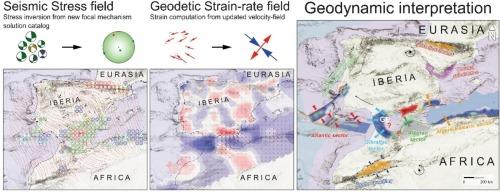地震应力场和大地应变率场对伊比利亚和西北非洲活跃地球动力学的新认识
IF 7.2
1区 地球科学
Q1 GEOSCIENCES, MULTIDISCIPLINARY
引用次数: 0
摘要
高山造山运动期间欧亚大陆和非洲大陆的辐合作用驱动了复杂的地球动力学过程,涉及多个地壳块体。在大西洋-地中海过渡带,地球动力学受前伊比利亚微板块和阿尔博兰域两个主要板块控制。现今,这些由不同时代的大陆和海洋地壳组成的地壳域在当前的区域应力状态下表现出不同的变形行为。通过分析增强的震源机制目录和更新的GNSS速度场,我们以前所未有的分辨率约束了地壳应力-应变场。三个主要发现浮出水面。首先,该地区不同的地壳块体相互作用决定了沿板块边界的应力应变场,使我们能够定义四个板块:大西洋、直布罗陀、阿尔博兰和阿尔及利亚-巴利阿里。第二,在大西洋板块,应力直接在非洲和欧亚大陆之间转移,而在西部,应力被阿尔博伦域的薄大陆地壳和直布罗陀弧和泰尔科迪勒拉的大陆边缘吸收。这一框架与相对于伊比利亚西南部边缘的欧亚大陆斜辐合相结合,可以促进伊比利亚的顺时针旋转。低水平应变率的板内区域受区域压缩和其他由垂直应力驱动的地球动力过程的影响,仍然存在构造活动。该研究强调了基于网格的应力和应变率场联合分析对于理解复杂板块边界区域的地球动力学过程的价值。本文章由计算机程序翻译,如有差异,请以英文原文为准。

New insights on active geodynamics of Iberia and Northwestern Africa from seismic stress and geodetic strain-rate fields
The convergence between Eurasia and Africa during Alpine orogeny drives complex geodynamic processes, involving multiple crustal blocks. In the Atlantic-Mediterranean transition zone, the geodynamics is controlled by the two main plates, the former Iberian microplate and the Alboran Domain. Nowadays, these crustal domains, composed of continental and oceanic crust of varying ages, show distinct deformation behaviors under the current regional stress regime. Through analysis of an enhanced earthquake focal mechanism catalog and updated GNSS velocity field, we constrained the crustal stress–strain fields with unprecedented resolution. Three key findings emerged. First, the different crustal blocks interacting in the region determine the stress–strain fields along the plate boundary, allowing us to define four sectors: Atlantic, Gibraltar, Alboran, and Algero-Balearic. Second, in the Atlantic sector, stresses are directly transferred between Africa and Eurasia, while westward they are absorbed by the thinned continental crust of the Alboran Domain and the continental margins of the Gibraltar Arc and Tell Cordillera. This framework, combined with the oblique Eurasia-Africa convergence relative to the Southwestern Iberian margin, could facilitate the clockwise rotation of Iberia. Finally, intraplate regions with low horizontal strain-rates still show tectonic activity influenced by regional compression and other geodynamic processes driven by vertical stresses. This study highlights the value of combined grid-based stress and strain-rate field analysis for understanding geodynamic processes in complex plate boundary regions.
求助全文
通过发布文献求助,成功后即可免费获取论文全文。
去求助
来源期刊

Gondwana Research
地学-地球科学综合
CiteScore
12.90
自引率
6.60%
发文量
298
审稿时长
65 days
期刊介绍:
Gondwana Research (GR) is an International Journal aimed to promote high quality research publications on all topics related to solid Earth, particularly with reference to the origin and evolution of continents, continental assemblies and their resources. GR is an "all earth science" journal with no restrictions on geological time, terrane or theme and covers a wide spectrum of topics in geosciences such as geology, geomorphology, palaeontology, structure, petrology, geochemistry, stable isotopes, geochronology, economic geology, exploration geology, engineering geology, geophysics, and environmental geology among other themes, and provides an appropriate forum to integrate studies from different disciplines and different terrains. In addition to regular articles and thematic issues, the journal invites high profile state-of-the-art reviews on thrust area topics for its column, ''GR FOCUS''. Focus articles include short biographies and photographs of the authors. Short articles (within ten printed pages) for rapid publication reporting important discoveries or innovative models of global interest will be considered under the category ''GR LETTERS''.
 求助内容:
求助内容: 应助结果提醒方式:
应助结果提醒方式:


